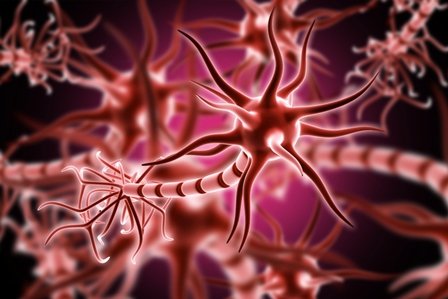NMDA receptor (NMDAR) mini-review
 Overview
Overview
NMDA receptors (NMDARs) are voltage-dependent and ligand-gated ionotropic glutamate receptors that in addition to glutamate, require co-activation with glycine or D-serine for efficient activation [1].
NMDARs are modulated by various compounds and act as non-specific cation channels for Na+ K+ and Ca2+ [2]. Mg2+ blocks NMDARs in a voltage-dependent manner when the cell is polarised, while Zn2+ blocks the channel in a non-competitive voltage-independent manner [3].
When the receptor opens, an influx of Ca2+ occurs - this is essential in processes such as synaptic plasticity which is an important mechanism in learning and memory. NMDARs mediate synaptic plasticity via long-term potentiation (LTP) and long-term depression (LTD) [4] which require Ca2+ influx to activate signalling cascades associated with AMPA receptor expression at the synapse [5].
Structure of NMDA receptors

For activation of NMDA receptors containing GluN1 and GluN2, two agonists need to bind: glutamate binds to the S1 and S2 regions of the GluN2 subunit and glycine to the S1 and S2 regions of the GluN1 subunit (see figure 1). The GluN2B subunit also possesses a binding site for polyamines which are regulatory molecules that modulate the functioning of the NMDA receptor.
The minimal requirement for functional NMDA receptors in vitro is a di-heteromeric assembly of GluN1 and at least one GluN2 subunit variant. However, more complex tri-heteromeric assemblies, incorporating multiple subtypes of GluN2 subunit, or GluN3 subunits, can be generated in vitro and occur in vivo.
There are many proteins associated with NMDA receptors with important roles in transport of the receptor and structural roles tethering other proteins. Read about some of the major NMDA associated proteins here.
Function of NMDA receptors
The NMDA receptor functions as a modulator of synaptic response and a co-incidence detector. At resting membrane potentials NMDA receptors are inactive. This is due to a voltage-dependent block of the channel pore by magnesium ions, preventing ions flowing through it. Once the channel inhibition is released, by for example, sustained activation of AMPA receptors that depolarise the post-synaptic cell, the NMDA receptor can be activated. This activation leads to a calcium influx into the post-synaptic cells that can initiate a wide range of signalling cascades for example:
- activation of CaMKII and phosphorylation of the GluA2 AMPA receptor subunit resulting in LTP (HFS)
- activation of PICK1 to drive the PKC-dependent synaptic insertion of AMPA receptors during LTP
- activation of hippocalcin, a Ca2+-binding protein that recruits AP2 to the GluA2 AMPA receptor subunit prior to internalisation during LTD (LFS)
- activation of PI3K/Akt/GSK3 to modulate LTP
Pharmacology of NMDA receptors
Following the work by Watkins and colleagues showing that prototypic agonist NMDA selectively activates the NMDAR, there has been a great deal of interest in identifying NMDAR compounds. A variety of agonists, antagonists, blockers and modulators have been found for the NMDAR’s glutamate and glycine binding sites as well as the ion channel pore and allosteric sites.
This has helped the discovery that the NMDAR plays an important role in many physiological processes such as synaptic plasticity and transmission, learning and memory as well as in pathophysiological conditions such as Parkinson’s, Huntington’s, schizophrenia and stroke [6].
NMDA receptor competitive antagonists
Acting at the glutamate binding site, D-AP5 is a commonly used NMDA receptor antagonist, It shows a slight preference for GluN2A andGluN2B containing NMDA receptor complexes, with a 5-fold lower Ki value for GluN1/2A over GluN1/2D complexes. Subunit selective antagonists include Ro 04-5595 (GluN2B selective), and UBP141 (GluN2D selective).
NMDA receptor channel blockers
NMDA receptor channel blockers act by binding to the pore of the NMDA receptor channel and are therefore non-competitive antagonists. MK-801 is a commonly used, high affinity non competitive antagonist.
NMDA receptor polyamine site antagonists
Polyamines modulate NMDA receptor function and bind to a site on the GluN2B subunit. Ro 8-4304 is an example of a GluN2B antagonist.
Glycine co-agonist site (S1S2 domain of GluN1)
| Glycine | Inhibitory neurotransmitter, NMDA receptor co-agonist |
| D-Serine | NMDA receptor co-agonist |
| Cycloserine | GluN2B subunit selective NMDA receptor partial agonist |
| (R)-HA-966 | NMDA receptor glycine site antagonist / partial agonist |
| CNQX | Potent, competitive AMPA / kainate receptor antagonist. Disodium salt. |
| DNQX | Selective, competitive AMPA / kainate receptor antagonist |
| L-689,560 | Potent, selective glycine site NMDA receptor antagonist |
| MDL-105,519 | Potent, selective glycine site NMDA receptor antagonist |
Glutamate binding site (S1S2 domain of GluN2)
| NMDA | Prototypic NMDA receptor agonist |
| D-AP5 | Selective, competitive NMDA receptor antagonist |
| (R,S)-CPP | Potent NMDA receptor antagonist |
| D-CPPene | Potent, competitive NMDA receptor antagonist |
| NVP AAM-077 | Potent, competitive NMDA receptor antagonist |
| UBP141 | GluN2D subunit selective NMDA receptor antagonist |
| UBP145 | GluN2C/2D preferring antagonist |
Channel blockers
| Ketamine | Non-competitive NMDA antagonist |
| MK-801 | Potent, selective, non-competitive NMDA receptor antagonist |
| Memantine | Non-competitive NMDA receptor antagonist |
| Dextromethorphan | Low affinity NMDA receptor antagonist |
| PCP | Non competitive NMDA receptor antagonist |
Negative allosteric modulators
| Ifenprodil | Non-competitive GluN2B subunit selective NMDA receptor antagonist |
| Ro-25-26981 | GluN2B subunit selective NMDA receptor antagonist |
| CP-101606 | Potent, selective NMDA receptor (NR2B subunit) antagonist |
| TCN 201 | Potent, non-competitive GluN2A subunit selective NMDA receptor antagonist |
| QNZ46 | NR2C/NR2D-selective NMDA receptor non-competitive antagonist |
| Neu-2000 | NR2B-selective, moderate NMDA receptor antagonist |
Positive allosteric modulators
| Pregnenolone sulphate | NMDA potentiator |
| CIQ | Non-competitive GluN2B subunit selective NMDA receptor antagonist |
| UBP710 | Potentiates GluN1/GluN2A and GluN1/GluN2B responses |
NMDA receptor mini-review references
- Laube B, Hirai H, Sturgess M, Betz H, Kuhse J 1997. Molecular determinants of agonist discrimination by NMDA receptor subunits: analysis of the glutamate binding site on the NR2B subunit. Neuron. 18(3):493-503.
- Collingridge GL, Olsen RW, Peters J, Spedding M. 2009 A nomenclature for ligand-gated ion channels. Neuropharmacology. 56(1):2-5.
- Liu Y, Zhang J. 2000. Recent development in NMDA receptors. Chin Med J (Engl). 113(10):948-56.
- Wu LJ, Toyoda H, Zhao MG, Lee YS, Tang J, Ko SW, Jia YH, Shum FW, Zerbinatti CV, Bu G, Wei F, Xu TL, Muglia LJ, Chen ZF, Auberson YP, Kaang BK, Zhuo M. (2005). Upregulation of forebrain NMDA NR2B receptors contributes to behavioral sensitization after inflammation. J Neurosci 25, 11107-11116. Zhuo M (2009) Plasticity of NMDA receptor NR2B subunit in memory and chronic pain. Mol Brain, 2:4 (review).
- Loescher C, Malenka RC. 2012 NMDA receptor-dependent long-term potentiation and long-term depression (LTP/LTD). Cold Spring Harb Perspect Biol.. 1:4(6)
- Furukawa H, Singh SK, Mancusso R, Gouaux E. 2005. Subunit arrangement and function in NMDA receptors. Nature. 438(7065):185-92.
NMDA receptor recommended reading
Collingridge GL, Volianskis A, Bannister N, France G, Hanna L, Mercier M, Tidball P, Fang G, Irvine MW, Costa BM, Monaghan DT, Bortolotto ZA, Molnar E, Lodge D, Jane DE (2013) The NMDA receptor as a target for cognitive enhancement. Neuropharmacology 64, 13-26. Leeson, P.D., Iversen, L.L., (1994). The glycine site on the NMDA receptor: structure–activity relationships and therapeutic potential. J. Med. Chem. 37, 4053–4067. Lodge, D., Johnson, K.M., (1990). Noncompetitive excitatory amino acid receptor antagonists. Trends Pharmacol. Sci. 11, 81–86. Monaghan DT, Irvine MW, Costa BM, Fang G, Jane DE (2012) Pharmacological modulation of NMDA receptor activity and the advent of negative and positive allosteric modulators. Neurochemistry International 61, 581-592. Traynelis, S.F., Wollmuth, L.P., McBain, C.J., Menniti, F.S., Vance, K.M., Ogden, K.K., et al., (2010). Glutamate receptor ion channels: structure, regulation, and function. Pharmacol. Rev. 62, 405–496. Evans, R.H., Francis, A.A., Jones, A.W., Smith, D.A.S., Watkins, J.C., (1982). The effects of a series of w-phosphonic a-carboxylic amino acids on electrically evoked and amino acid induced responses in isolated spinal cord preparations. Br. J. Pharmacol. 75, 65–75.
Additional glutamate receptor resources
- Browse glutamate receptor agonists, antagonists and modulators
- NMDA receptor associated proteins mini-review
E-Alerts
If you liked this, then why not sign up for our e-Alerts? We will let you know when we add new mini-reviews, pathway posters, product guides and fast facts. Sign up now





 Overview
Overview